Yonge Street Improvements
Davis Drive to Green Lane
Town of Newmarket and Town of East Gwillimbury
York Region is improving Yonge Street from Davis Drive to Green Lane in the Town of Newmarket and Town of East Gwillimbury. This multi-year project will support growth and create an efficient, safe and attractive roadway for travellers - whether driving, walking, cycling or taking transit.
Phase two starts: Summer 2025
Anticipated completion: Late 2027

Future rendering of Yonge Street south of Green Lane

Impacts to travellers
- Lane reductions outside of peak travel times
- Traffic lane shifts to accommodate construction
- Night work and weekend work as required to expedite the project
- Temporary impacts to sidewalks and entrances
- Access to businesses will be maintained
Project Update
Crews are widening the road from four to six lanes and improving comfort and safety for pedestrians and cyclists. Improvements will include:
- High Occupancy Vehicle (HOV) lanes
- Wider sidewalks
- New cycle tracks
- Streetscaped centre medians
- Upgraded traffic signals and lighting
- Freshly paved road surface
Phase one was complete in fall 2024. Work included installing retaining walls, noise barriers and temporary traffic signals, and relocating hydro lines, watermains and utilities. Traffic signals were realigned at the Upper Canada Mall and the NewRoads GM dealership. Crews also replaced a hydro plant on Yonge Street to support electrical distribution system upgrades that are necessary for future development.
Subscribe to the Yonge Street Improvements e-newsletter.
About the Project
Project Details and Benefits to the Community
The Yonge Street improvement project has many benefits to help with future growth and development in the Town of Newmarket and Town of East Gwillimbury, including:
- Road widening from four lanes to six lanes, including High Occupancy Vehicle (HOV) lanes
- Upgrading five traffic-signal controlled intersections for enhanced accessibility, including audible pedestrian signals
- Installing new traffic signals at the plaza entrances to Yonge Street at Canadian Tire and the Yonge-Kingston Centre for improved access into businesses
- Relocating the traffic signals currently located at the intersection outside of Upper Canada Mall for better alignment of the road network for future growth
- Replacing existing sidewalks to wider sidewalks and bicycle paths within the boulevards on each side of Yonge Street
- Installing new street lighting using more sustainable LED fixtures that save energy, create better nighttime visibility and make streets safer for drivers, pedestrians, and cyclists
- Creating a centre median along Yonge Street to protect for future rapid transit, when needed and when funding becomes available
- Streetscaping in the boulevards and centre median with trees, shrubs, and upgraded finishes to help achieve the vision of a vibrant, green, and active place in the community
Yonge Street Photos - Before and After
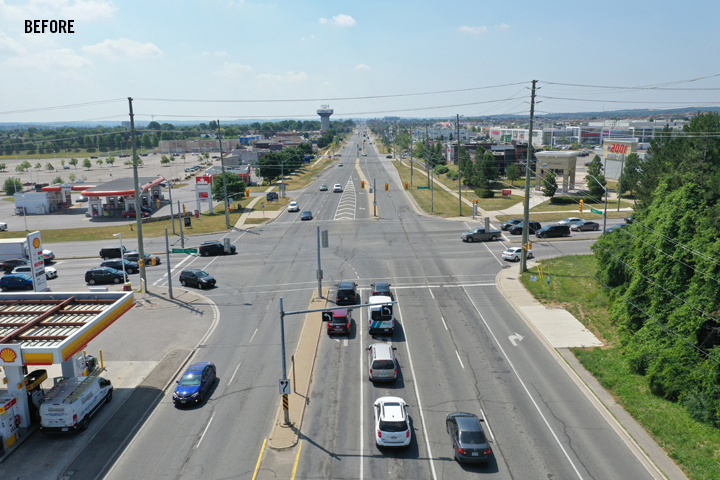
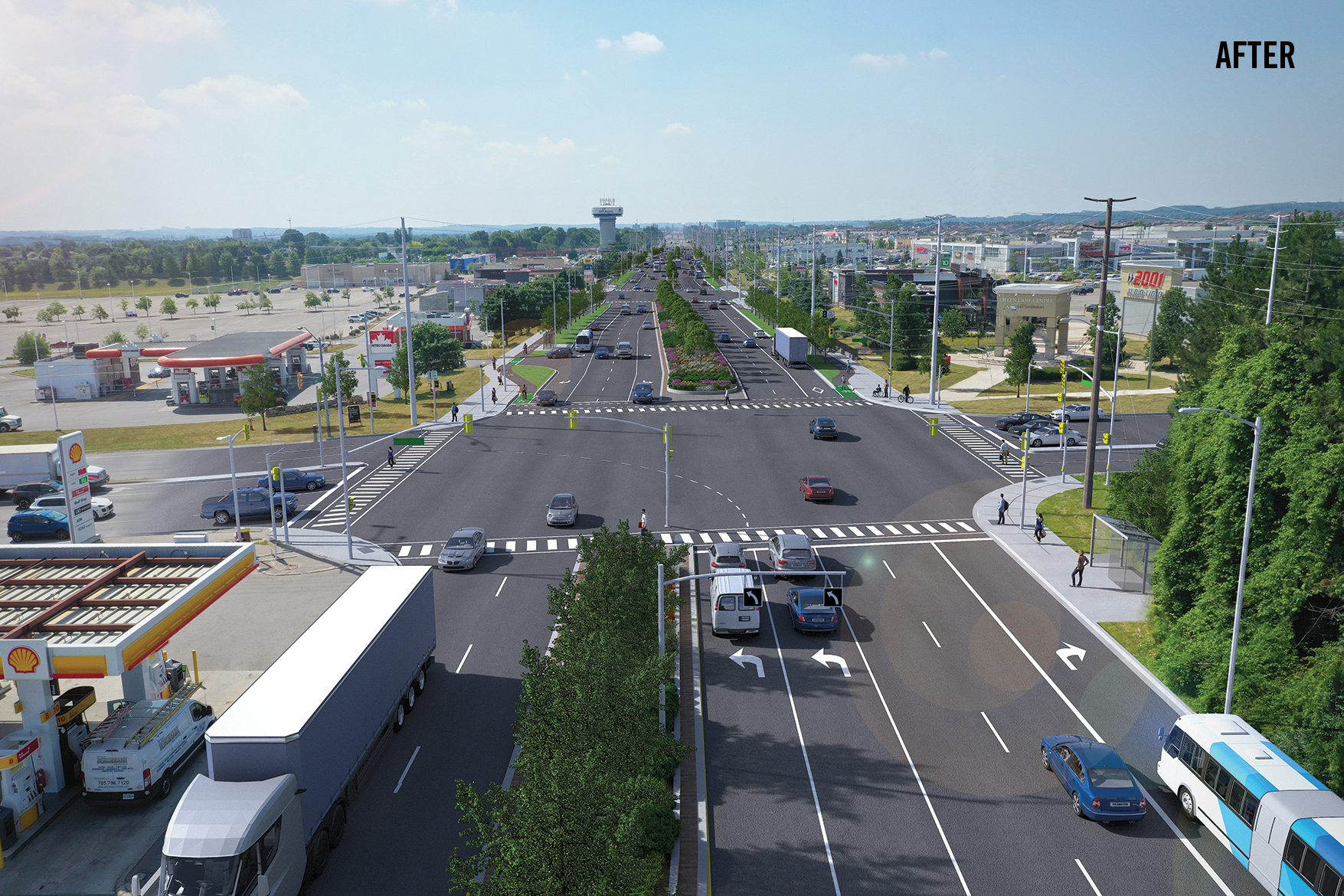
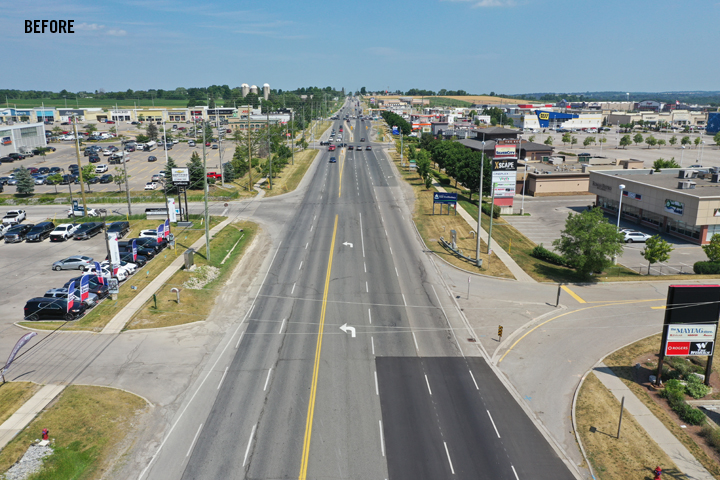
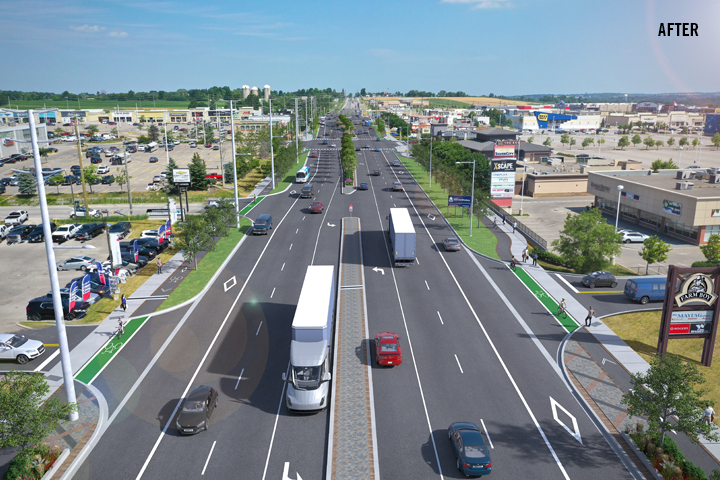
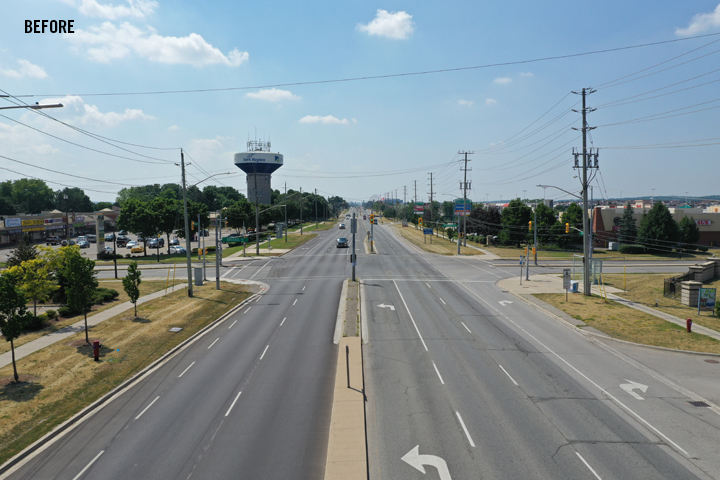
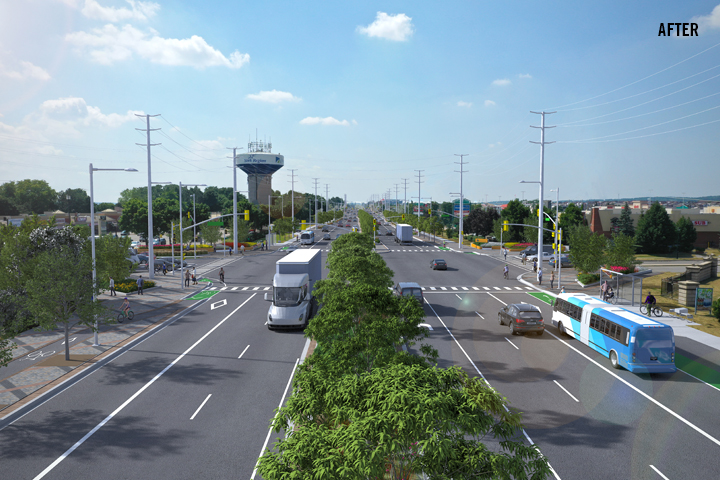
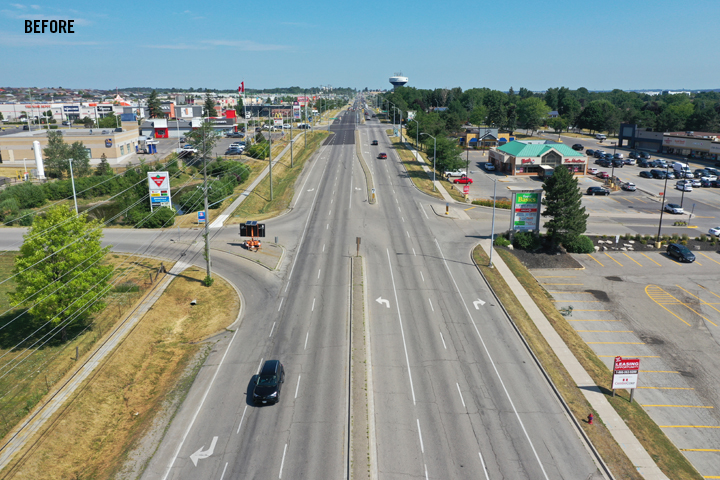
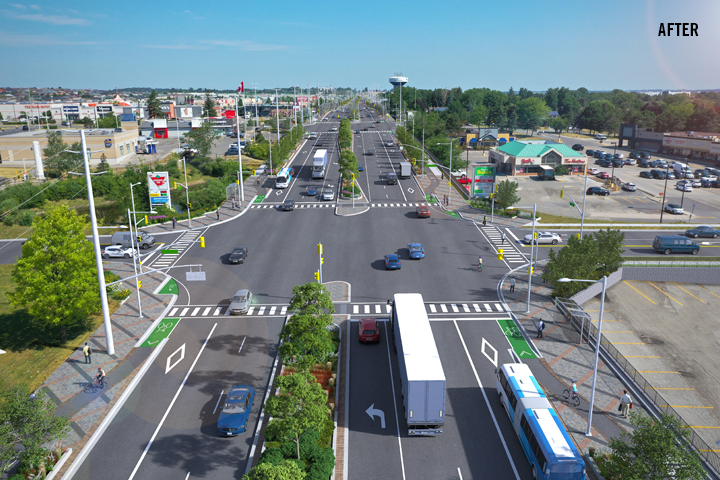
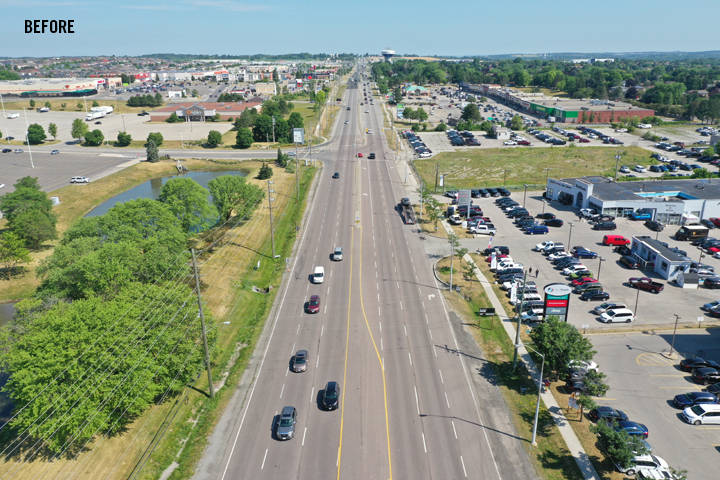
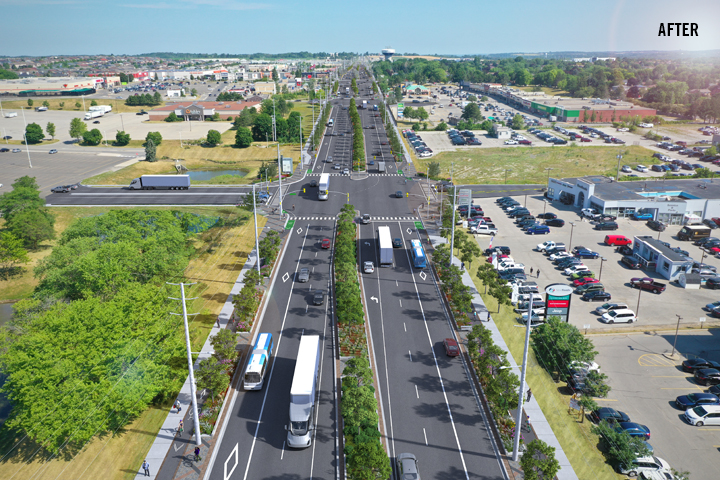
Other Projects in the Area
Multiple road projects are happening in your community to keep assets in a good state of repair, enhance safety and accommodate growth.
View map showing all projects in the Towns of East Gwillimbury and Newmarket
Frequently Asked Questions
Project Background and Timelines
Why are these improvements taking place?
- To accommodate future growth, the growing population and increase in travellers in the area
- In 2025, the number of vehicles expected to travel along this section of Yonge Street is 50,000 per day
- Pedestrian travel on Yonge Street north of Davis Drive during peak hours is anticipated to grow by approximately 50% in 2031 and by almost 400% by 2041
- These improvements will alleviate traffic and provide a safe, more reliable roadway that is inclusive for all users
What will the improvements look like?
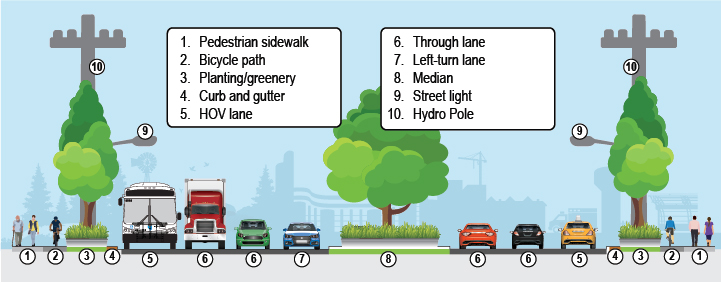
Why did utility relocation take several years?
- Approximately 200 hydro poles, utility pedestals and manholes were removed, transferred and installed covering a distance, if laid out end to end, of over 20,000 metres within the project limits
- Due to the amount of utility companies and the work involved, the seven companies could not safely complete the utility work at the same time
- Some utilities were very sensitive and could have affected a lot of people, if the work is not executed properly. Many of the utility lines in the area connects York Region to other cities/towns across Ontario
- The work was completed cautiously to ensure residents and business owners always had power, gas and internet during this work and beyond
How does this project compare to the work that took place on Davis Drive?
- The differences between the Davis Drive project and the project on Yonge Street include:
- Davis Drive is a much narrower roadway, which increased the construction impact to travellers on the road due to lane closures and lane width reductions during construction
- Part of the project scope on Davis Drive and Yonge Street south, included the installation of a centre median rapid transit facility. The Yonge Street from Davis Drive to Green Lane project is not constructing a rapid transit facility
- 30,210 vehicles per day travel on Davis Drive. 50,000 vehicles per day travel on Yonge Street
How does York Region choose which roads are widened?
All Regional roads are part of an annual review, with improvements prioritized and approved by York Regional Council. Priorities include:
- The Region’s most congested areas to provide greater capacity and more travel options
- Major employment areas to enhance access to transit and highways
- Connections to major highways and provincial investments like the subway extension
How much work goes into preparing road projects for construction?
- It takes eight to ten years to deliver major road projects
- An environmental assessment study, road design, property acquisition, utility relocation and permits must be completed before construction can begin
- Coordinating work with our partners, including ministries, local cities and towns, conservation authorities, utility companies and developers is important to ensure disruption to travellers and the community is minimized
How can a construction project get delayed?
- Weather is a large factor in delaying a construction project
- To conduct paving work, weather conditions must be ideal, the surface must be dry and above a specified temperature, depending on the type of asphalt being used
- Environmental permits restrict work during some seasons to protect wildlife and the natural environment
- Unknown factors
- During excavation, contaminated soil could be uncovered and would need to be disposed of at an approved and registered waste disposal site, capable of receiving hazardous and waste material, as authorized in the Environmental Protection Act
- During excavation, unknown underground utility conflicts can be found
- COVID-19 and Public Health guidelines
- Labour and material shortages
This video explains why construction may be paused or delayed: Why has work stopped?
Amenities and Project Features
Will sidewalks be maintained?
- A minimum of one sidewalk will be maintained between signalized intersections throughout construction for pedestrian use
- During utility work, sidewalks may be temporarily relocated or closed to facilitate work. Pedestrians are to follow the directional signs to use an open sidewalk and to not use the roadway
Is access to businesses going to be maintained?
- Yes. Access to businesses will be maintained throughout construction
- Business supports will be provided as they become available. If you are a business owner in the area and have questions, please contact @email
Is a rapid transit facility being installed as part of this project?
- A rapid transit facility is not being constructed. A centre median is being built along Yonge Street. This will allow for a future rapid transit facility, when the time is right, population demands it, and when the population, traveller and transit ridership is there
Why is a centre median being installed?
- A centre median is being installed as part of this work to eliminate the need to go back and build the necessary infrastructure, if there is demand in the future, for dedicated rapid transit facilities
- A centre median is built to guide traffic and eliminate mid-block left turns, which keeps traffic moving and can be a contributing factor in collisions
- A centre median will also provide more spaces for planting
Why are bicycle lanes being installed in the boulevard and not on the roadway?
- The original Environmental Assessment design had bicycle lanes on the roadway
- After consulting with York Region’s Sustainable Mobility team and the Town of Newmarket and Town of East Gwillimbury, it was recommended the bicycle lanes be installed within the boulevard for a more functional, inclusive streetscape design
- The design was revised based on the recommendations as this best met the needs of the travelling public
Why are High-Occupancy Vehicle (HOV) lanes being installed?
- York Regional Council endorsed implementation of transit/HOV lanes for all projects widening roads from four to six lanes
- Transit/HOV lanes increase capacity on busy corridors and support planned growth to better serve residents in York Region
- HOV lanes move more people through busy corridors in fewer vehicles, reducing emissions and providing incentives for travellers to use greener modes of transportation
- The Ministry of Transportation of Ontario website has guidelines about driving in HOV lanes
Why weren't hydro lines installed underground instead of overhead wires?
During the planning process, we evaluated the option of overhead versus underground installation based on many factors, including technical feasibility, reliability considerations, costs, land acquisition needs and project schedule. Once consultation and evaluation were complete, the decision was to proceed with overhead infrastructure. This decision is consistent with phase one (Mulock Drive to Davis Drive) and similar projects throughout the province. If you have any further questions, please contact ntpower.ca/contact.
Traffic Impacts
What are the impacts to traffic?
- Traffic will be reduced to a single lane outside of peak travel times
- Traffic lane shifts to accommodate construction
- Access will be maintained for all driveways/entrances
Do I need to allow extra time to get through this road section?
- We are working to minimize disruptions as much as possible
- Please allow extra time to get through the corridor, which is about two kilometres
- Signs will guide travellers through the corridor, including expected travel times
- Traffic and navigation tools can help travellers plan ahead
- This video highlights the importance of driving safely through work zones: Drive safely around work zones
How are you trying to minimize travel impacts?
- York Region reviews the corridor of each project to determine how to manage traffic delays during construction
Will traffic signal timing be adjusted to improve traffic flow?
- York Region actively monitors traffic signal timing through staff on-site during construction and remotely from the Roads and Traffic Operations Centre
- While it is everyone’s desire that they get the maximum green time so that they can proceed through an intersection as soon as possible, adjusting traffic signal timing is a matter of balancing supply (green time on one road) and demand (delay on the crossing road)
- Improving traffic flow on any road by providing more time green time for better progression, means taking away time from the road in the conflicting direction
- The ability to provide more green time is also limited by the need to provide time for pedestrian crossings
Will work be happening at night?
- Night work may be considered with lane reductions to expedite the project while minimalizing traveller delays. Advanced notice will be provided if it’s determined to be beneficial to efficiently progress the work
- Night work may be considered throughout construction for asphalt removal, paving and line painting work. This work is better performed at night and will minimize delays to traffic
Safety
What are the safety measures in place and how is safety considered?
- York Region conducts routine inspections of all its structures and determines the need for repair to ensure a reliable and safe travel for all users
- When construction projects are being planned and implemented, residents, businesses, travellers and the environment are all taken into consideration
- During the design phase of a construction project, the Region ensures we are meeting Accessibility for Ontarians with Disabilities Act requirements and the needs of all users within our transportation network
- York Region reviews hundreds of intersections each year and studies are completed to consider traffic and pedestrian volumes, future development, delay and collision history
- A Traffic Safety Report is produced each year to provide an understanding of road safety trends on Regional roads. This report supports the planning and execution of coordinated law enforcement, road safety improvements and public education campaigns for travellers in York Region. Reports can be viewed here
- Signage is installed around a construction area to let travellers know what is going on and how to travel safely through the work zone
Safety tips for motorists travelling through construction zones
- Many construction workers are injured or killed each year when working on roads. When driving through construction zones motorists must:
- Slow down early when approaching construction zones
- Be patient and obey signs and signal persons
- Merge well in advance when lanes are being reduced
- Avoid lane changes, give yourself extra space following and be ready to stop
- Do not speed up quickly when leaving construction zones
- Do not pass construction vehicles when their amber lights are flashing
- Plan ahead and expect delays
- Visit our Traffic Safety Program page for more safety tips
Safety tips for pedestrians and cyclists through construction zones
- It is very important to obey ALL work zone signs, workers and pavement markings
- Watch where you are going. Your primary responsibility is going through the work zone as safely as you can
- Orange Work Zone Signs – these signs communicate to drivers, pedestrians and cyclists what is going on and how to travel safely through the work zone. They can also indicate that a sidewalk is closed and that a detour must be taken
- Pavement Markings –painted or taped lines on the pavement separate car travel lanes and can also indicate pedestrian and cyclist paths
- During construction some sidewalks and crossings at intersections may be closed. Pedestrians may be required to move to the other side of the road or to a temporary pedestrian walkway
- Use designated pedestrian crosswalks and traffic lights to cross the street before reaching a construction zone and DO NOT cross in the middle of the road
- Avoid standing in close proximity to any construction machinery and open excavations while construction activities are taking place
- Please DO NOT walk on the roadway beside the barriers
- Please be alert and aware of your surroundings when travelling near construction areas
- Visit our Traffic Safety Program page for more safety tips
Contact Us and Stay Informed
How are residents kept informed about the project?
We are committed to keeping you informed throughout all stages of construction. Methods include:
A dedicated project page: york.ca/YongeStreet
- Road signs
- Mailings
- Outreach to local businesses
- Presentations
- Advertisements
- E-newsletters
- Social media
- Video
Where can I learn about traffic impacts related to construction?
Follow @YorkRegionGovt on Twitter and Facebook, continue to visit the project page and subscribe to our e-newsletter to have updates sent directly to your mailbox. We will provide advance notice for traffic impacts whenever possible and ensure signs are in place to guide travellers.
Who can residents contact if they have concerns or inquiries about the project?
- If you have any concerns or questions about this project, please contact: @email
Resources
General Inquiries:
York Region Transportation, Public Works
Phone: 1-877-464-9675 ext. 75000
TTY: Dial 711 with a TTY device
@email
After-hours emergency: 1-877-464-9675 ext. 75200


